Beetroot Crackers with Nigella Seeds
Beetroot Crackers not only look good but, speckled throughout with nigella seeds, they taste wonderful too.
The beetroot brings an attractive colour and earthy sweetness. The seeds, said to resemble anything from onion, cumin or oregano, add a contrasting mild bitterness that becomes quite addictive.
Exceptionally crunchy, Beetroot Crackers with Nigella Seeds are perfect with cheese, dips and spreads. But I love them just as they are, eaten as a snack.
Easy to make, the crackers should keep for at least 2 weeks in an airtight container.
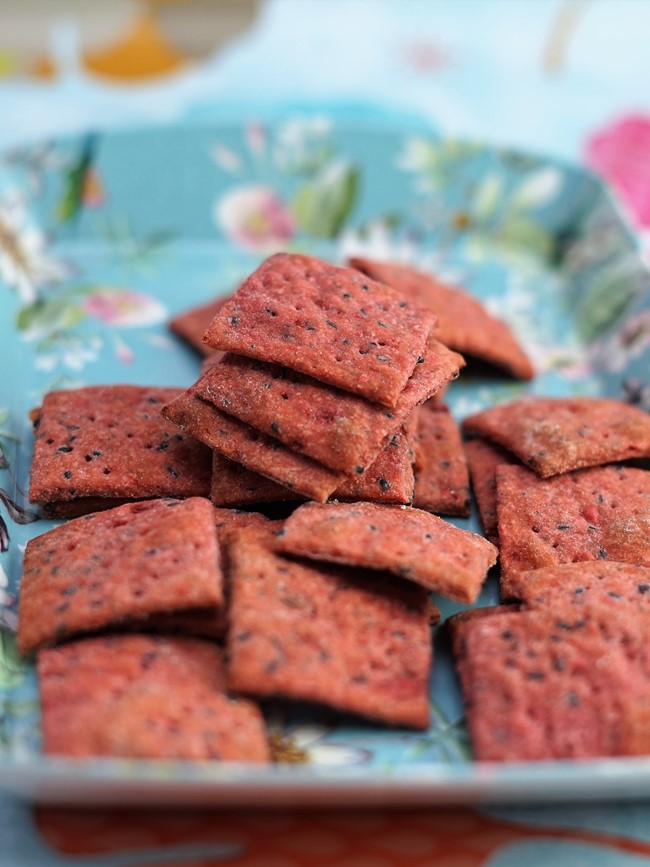
Jump to Recipe
I was prompted to make these Beetroot Crackers with Nigella Seeds after sampling some rather disappointing shop-bought beetroot and seed crackers.
Other half had been working away from home and had bought them as a semi-healthy nibble to keep him going. He hadn’t been overly impressed and had brought the remains home.
The crackers certainly looked and sounded the part. They were a bright beetroot colour and, seemingly rare these days, they didn’t contain palm oil.
But oh dear. They tasted of virtually nothing. Of course, I don’t expect beetroot cooked and dried in a cracker to taste the same as fresh. However, I do think at least some of the vegetable should be detectable.
Another look at the ingredients and it was easy to see where the problem lay. The beetroot content was just seven percent. And that was beetroot powder. No wonder they were so lacklustre.
So, a few days later when some lovely organic beetroots were included in my Moorland Veg Box delivery, I decided to see if I could do any better.
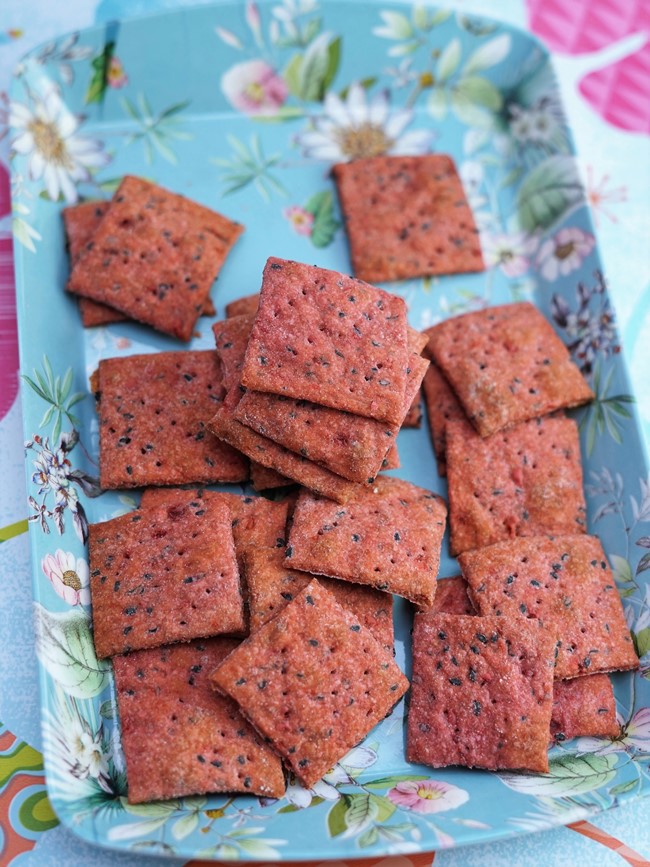
EASY HOMEMADE CRACKERS
The first port of call when developing my Beetroot Crackers had to be my recipe for Easy Homemade Crackers.
These have been hugely popular, so it seemed a good idea to base my new recipe on their solid foundations.

The basic dough is just your chosen combination of flours (plain white and wholemeal rye in those pictured above), salt, water, olive oil, plus any extras like herbs, spices, or seeds.
All I had to do was work out how to incorporate fresh beetroot into a cracker, then decide what flavours would complement it.
BEETROOT CRACKERS WITH NIGELLA SEEDS
My first thought was to turn to my juicer. Perhaps I could simply replace the water in my basic cracker recipe with beetroot juice?
But I decided against it for two reasons.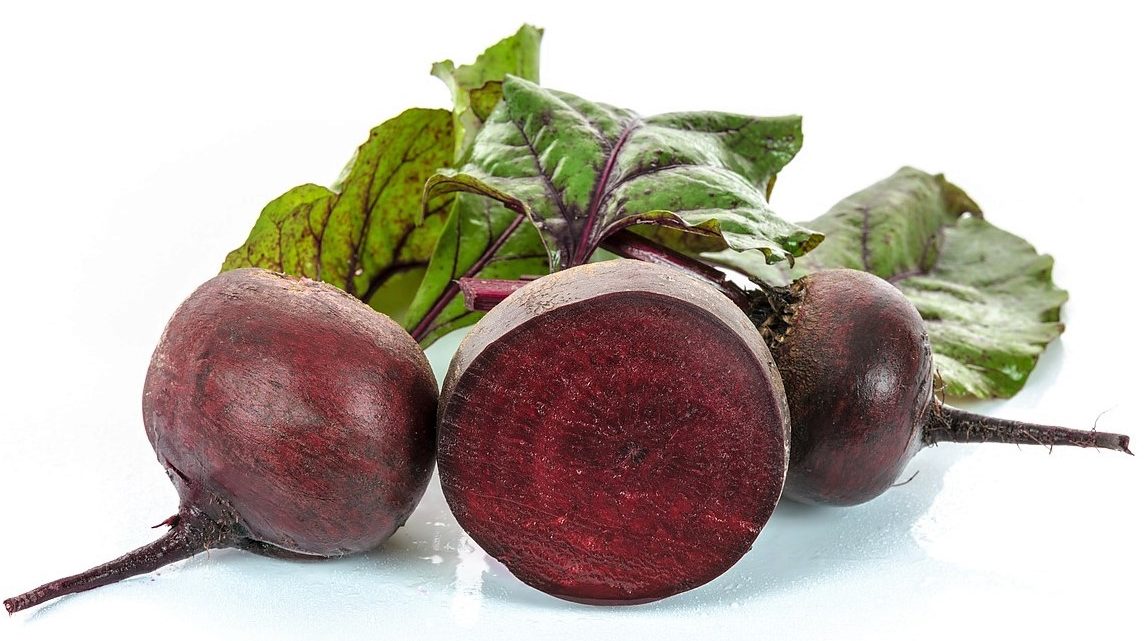
Firstly, knowing I wanted to share any successful recipe, requiring you to have a juicer would necessarily limit who could give it a try.
Secondly, as crackers are largely carbohydrate and fibre anyway, it seemed silly to extract the juice and leave all beetroot’s carbs and fibre behind.
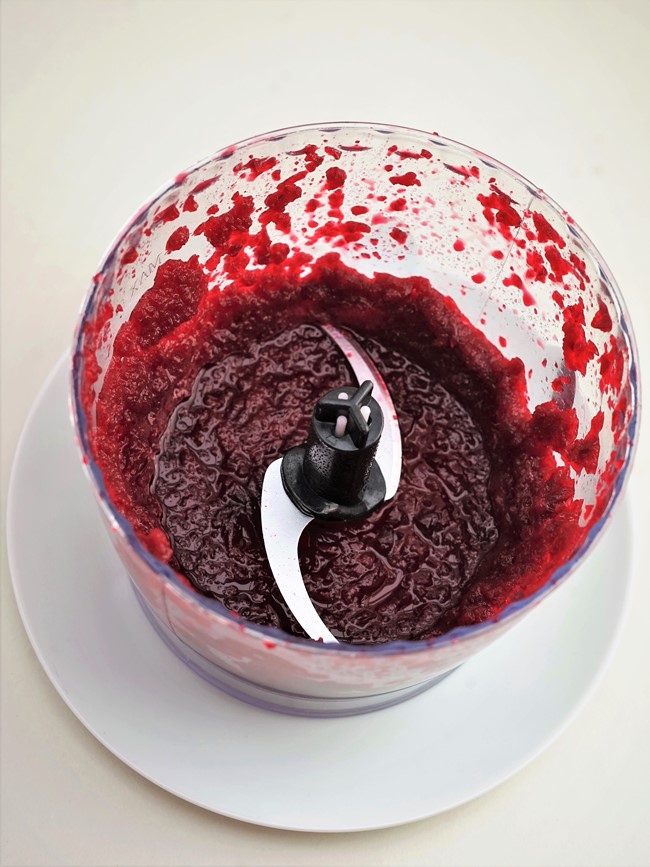
So, I decided to whizz up a medium-large cooked beetroot (including a little water to help it along) and use the resulting thick mixture instead of water. Neat eh?
You can whizz the beetroot to a completely smooth puree if you like. But I prefer it slightly chunkier, so you get flecks of beetroot in the dough and finished crackers.
NIGELLA SEEDS
For additional flavour in the Beetroot Crackers, I chose nigella seeds.
Apart from liking the contrast of black seeds against the pink crackers, I thought their intriguing, slightly bitter taste would be great against the sweet earthiness of beetroot.
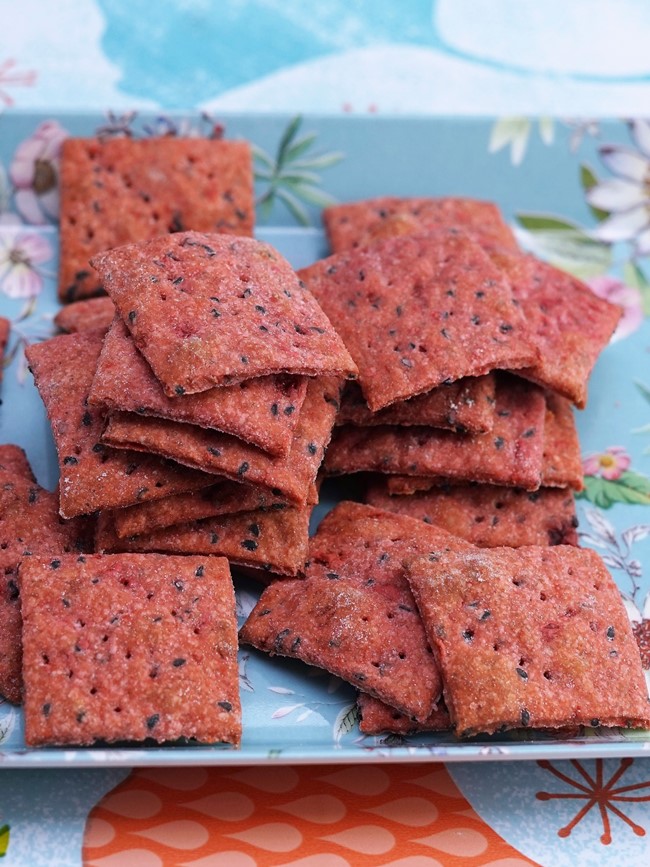
Often misnamed onion seeds, it’s hard to describe the flavour of nigella seeds. Some say they do have an onion flavour. Others compare them to cumin, oregano, or pepper and detect a smoky undertone.
If you’ve ever had naan bread or pakora that contained charcoal black seeds, then you’ve eaten nigella seeds.

But, although I first came across them in Indian cuisine, these days I love them in all sorts of things. Sausage rolls with apple, onion and fennel, sprinkled with nigella seeds, were especially good last Christmas.
EASY BEETROOT CRACKERS
The detailed recipe at the end of this post will make two baking trays full of crackers, assuming your trays are approximately 32 x 22 centimetres.
While the oven’s preheating, cut out two pieces of baking paper to fit the bottom of the trays.
To make the dough, you simply stir together the flour, nigella seeds, a little salt, some olive oil and the beetroot mush.

As different flours absorb varying amounts of liquid, add a little more water if you need to.
Give the dough a couple of folds and turns to form it into a ball.
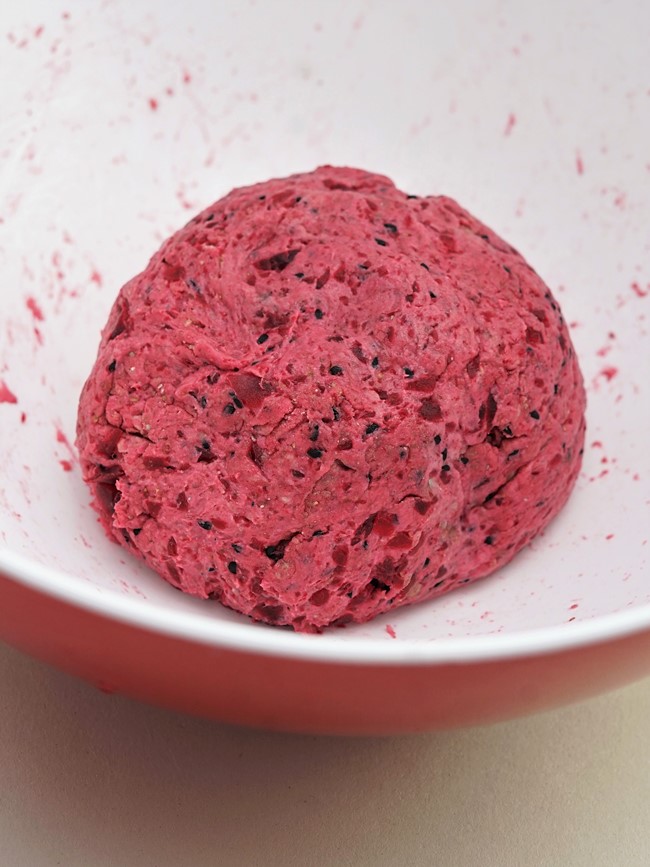
If you’ve made my Easy Homemade Crackers or my Sourdough Crackers then you’ll be familiar with my easy technique for rolling and cutting out.
Working with half of the dough at a time, you roll it out directly onto the baking paper. Roll it out to approximately the size and shape of the paper.
Tip: if you don’t want to stain your rolling pin beetroot pink, put another piece of paper over the dough before rolling out.
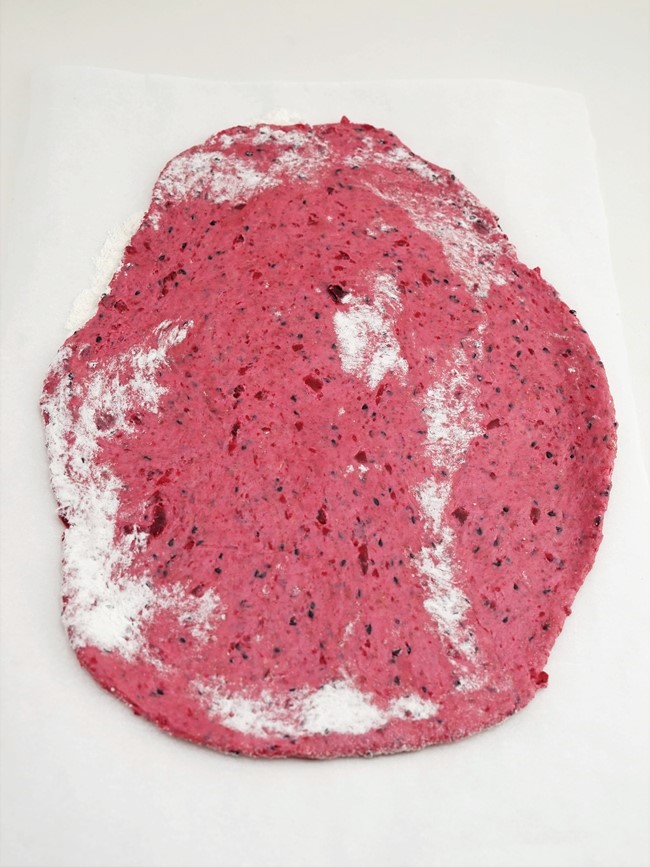
To get neat edges, trim off the excess with a pizza wheel or knife. If, like me, you’re incapable of marking a straight line freehand then use a ruler too.
Next, cut the dough into whatever size cracker you like, squares or rectangles. I cut these into roughly 4 x 4 centimetre squares which gave me 35 crackers per tray.
To stop the crackers bubbling up too much, prick a few times with a fork.
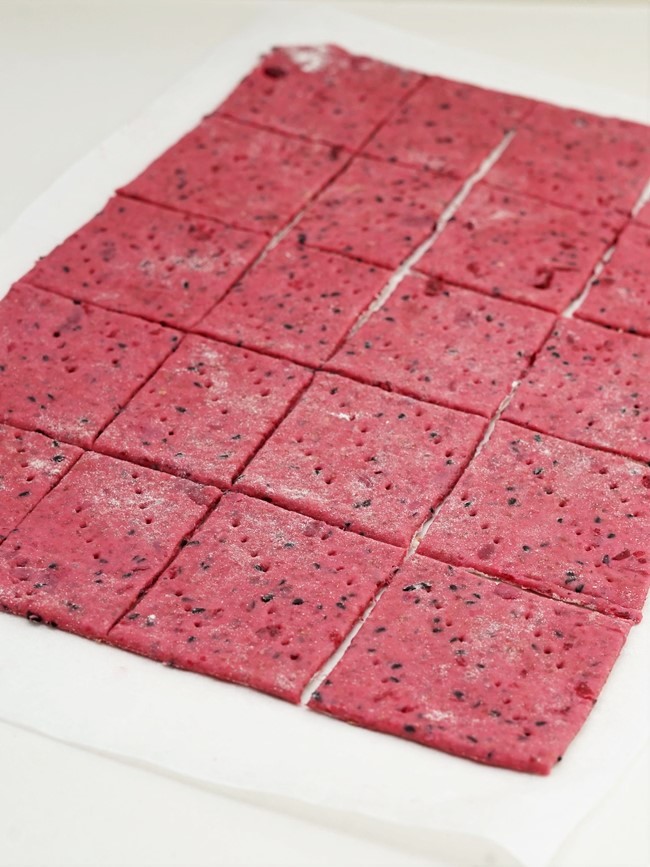
When ready to bake, slide the paper and crackers onto a baking tray.
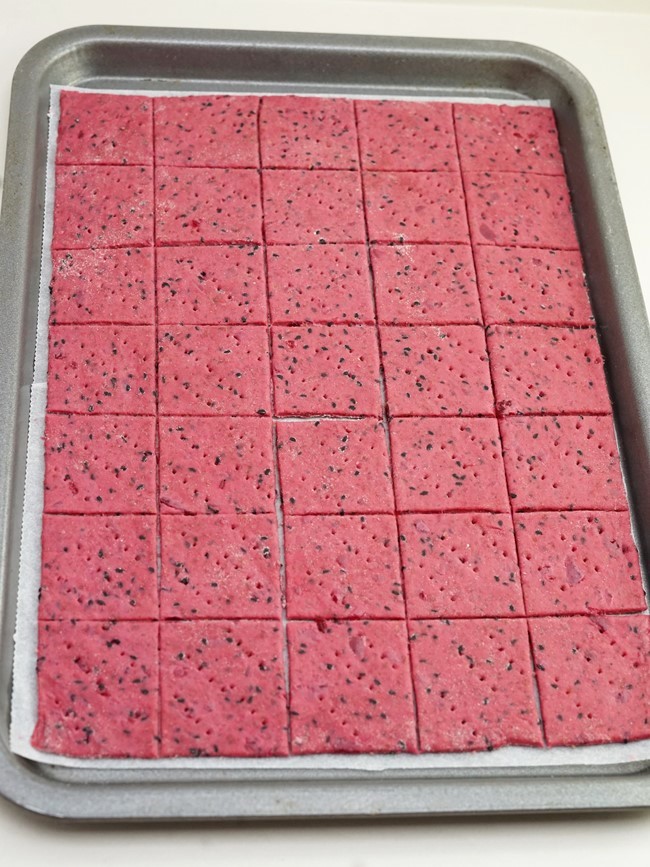
The crackers can then go into the oven while you repeat the process with the remaining dough to make a second tray of crackers.
BAKING THE CRACKERS
Presumably due to the extra moisture content brought by adding vegetable matter, I found that Beetroot Crackers took longer to cook than my regular homemade crackers. Around twenty-five minutes instead of fifteen.
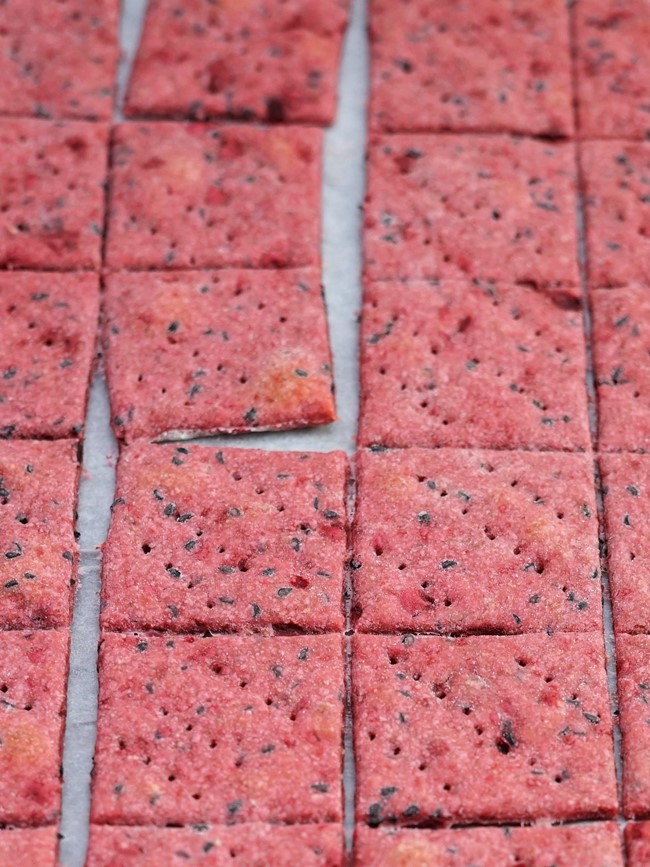
So that the tops didn’t get overdone during this extra time, I baked the second tray at a slightly lower temperature. I found this worked better so have recommended 200C / 180C Fan / Gas 6 in the recipe card.
As with other crackers though, those at the outer edges of the baking tray do tend to cook quicker. So just take them out and put the rest back in the oven to finish off.

I also like to turn the crackers over for the final few minutes to make sure they’re entirely cooked and crunchy all the way through. This is especially important with the higher moisture content of Beetroot Crackers.
SERVING & STORING
I’ve found with all my homemade crackers that, so long as they’re completely cold before storing, they will stay fresh and crunchy for at least two weeks.
With their great flavour, I think Beetroot Crackers with Nigella Seeds are lovely eaten on their own. But you can enjoy them as you would any other cracker: with cheese, dips or spreads. Or eat alongside soup instead of croutons or bread.
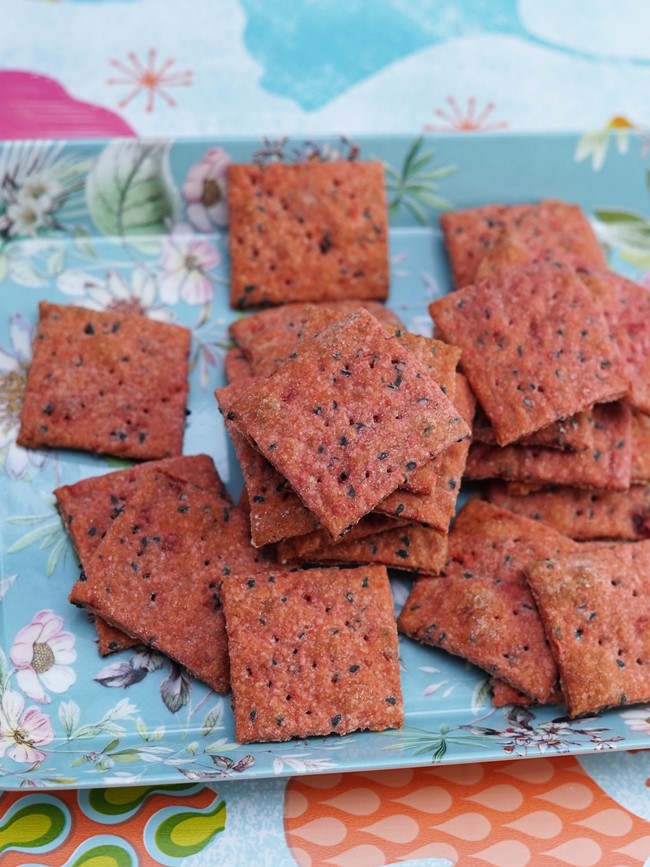
The beetroot flavour isn’t overly pronounced, but the sweetness is there and a little earthiness too. Combined with that is nigella’s intriguing taste.
Something of an experiment, the crackers turned out even better than I’d hoped.
I think Beetroot Crackers are going to become a regular in our house. And I’m already dreaming up new flavours of vegetable crackers to try.
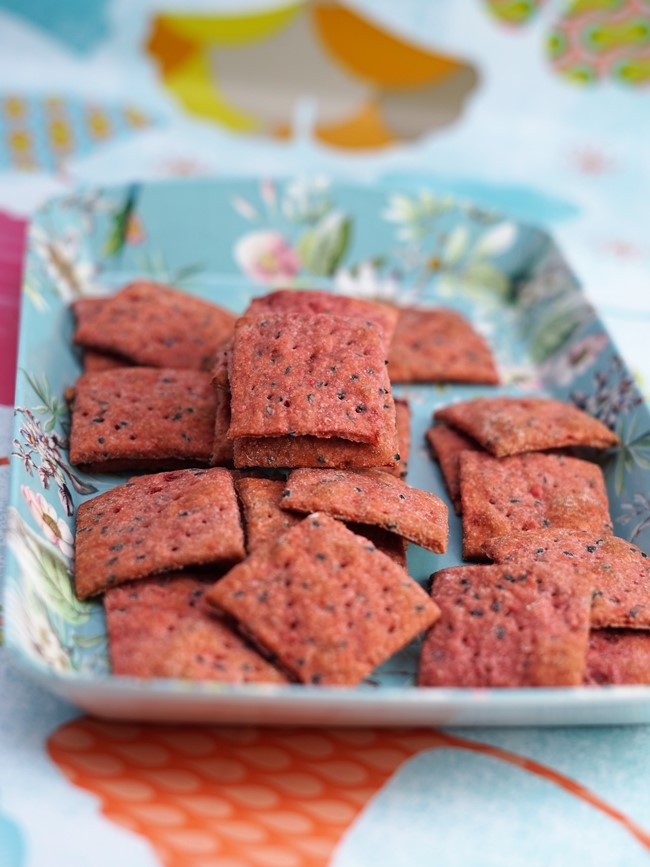
If you make Beetroot Crackers with Nigella Seeds, I’d love to know what you think.
Please leave a comment and don’t forget to rate the recipe.

Beetroot Crackers with Nigella Seeds
Crunchy & moreish, these easy crackers have an earthy sweetness combined with an intriguing and addictive mild bitterness.
Eat with cheese, dips and spreads, alongside soups or on their own as a snack.
Ingredients
- 125 g plain white flour (plus extra for rolling) see Recipe Note 1
- 50 g rye flour see Recipe Note 1
- 1 level tbsp nigella seeds
- ½ tsp salt
- 125-150 g cooked beetroot weight after peeling
- water refer to instructions for amount
- 30 ml olive oil
Instructions
-
Preheat the oven to 200C/180 Fan/Gas 6.
Cut 2 pieces of baking paper to fit 2 shallow baking trays approximately 32 x 22 cm.
-
Roughly chop the cooked beetroot and put it into a food processor with a splash of water.
Process until very finely chopped or completely pureed, depending on your preference.
Measure out 100ml of the mixture: top up with water if you don't have 100ml.
-
Put the flours, nigella seeds, salt, olive oil and the 100ml of beetroot mixture into a bowl.
Using a plastic spatula, bring everything together into a soft dough. Add a little more water if needed, but don't make the dough too wet.
-
Put one of the pieces of baking paper on the worksurface and dust with a little flour.
Cut the dough in half: put one half on the dusted baking paper and cover the other half with the upturned bowl to prevent it drying out.
Lightly dust a rolling pin and the dough, then roll it thinly so it fits the approximate shape of the paper.
Tip: if you don't want the beetroot to stain your rolling pin, cover the dough with another piece of baking paper before rolling out.
-
Use a ruler and a pizza wheel or knife to cut off excess dough so that the edges are straight (add scraps to the dough half you reserved).
Cut the dough into squares or rectangles of your chosen size (be careful not to cut through the paper).
Slide the baking paper and crackers onto a baking tray.
-
Put in the preheat oven and bake until cooked through and crispy (18-25 minutes)
Tip 1: Crackers at the edges of the tray may cook more quickly, so remove them before they burn.
Tip 2: As the dough is moist due to the beetroot, you may need to turn the crackers over part way through to ensure they're dry and crisp throughout.
While the crackers are baking, repeat the process with the remaining dough.
-
Transfer the crackers to a wire rack and leave until completely cold before storing in an airtight container.
Beetroot Crackers should keep fresh for at least 2 weeks.
Recipe Notes
Note 1. Use your own favourite flours if preferred.
